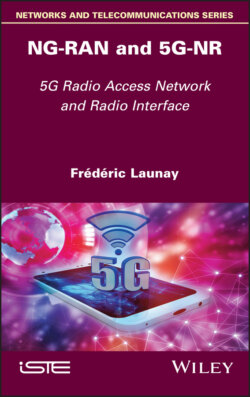Читать книгу NG-RAN and 5G-NR - Frédéric Launay - Страница 22
1.3.1.2. The identity of the mobile at the level of NG-RAN
ОглавлениеEach NG-RAN node manages a set of mobiles. The NG-RAN node assigns a specific RNTI radio identifier to each mobile. A broadcast identifier is also used to broadcast information like the common control channel and information system.
Consequently, for any mobile in the standby mode, the NG-RAN node uses the following radio identities:
1 – P-RNTI (Paging) to send a paging request;
2 – SI-RNTI (System Information) to broadcast SIB messages;
3 – RA-RNTI (Random) to identify a mobile when requesting radio access (random access procedure; see Chapter 3);
4 – TC-RNTI (Temporary Cell) which helps to retrieve the information exchanged during the connection procedure, following the random procedure.
If the mobile is in the RRC_INACTIVE state (in the standby mode) on the NG-RAN, its identifier is called I-RNTI.
If the mobile is in the RRC_CONNECTED state, connected with the NG-RAN node, then several radio identities are used per mobile:
1 – C-RNTI (Cell): unique identification of the mobile for the RRC connection and for scheduling;
2 – CS-RNTI (Configured Scheduling): radio identifier of the mobile for the RRC connection and for semi-persistent scheduling;
3 – SP-CSI-RNTI (Semi-Persistent): radio identifier of the mobile used for the transmission of radio channel information (CSI: Channel State Information) on the uplink traffic channel with semi-persistent scheduling;
4 – MCS-RNTI (Modulation Coding Scheme): radio identifier of the mobile to indicate the modulation and coding scheme (MCS) of the mobile for the transmission of data on the downlink and uplink traffic links;
5 – TPC-RNTI (Transmit Power Control RNTI) is used to retrieve the information corresponding to the power control for both the traffic and uplink control channels.
